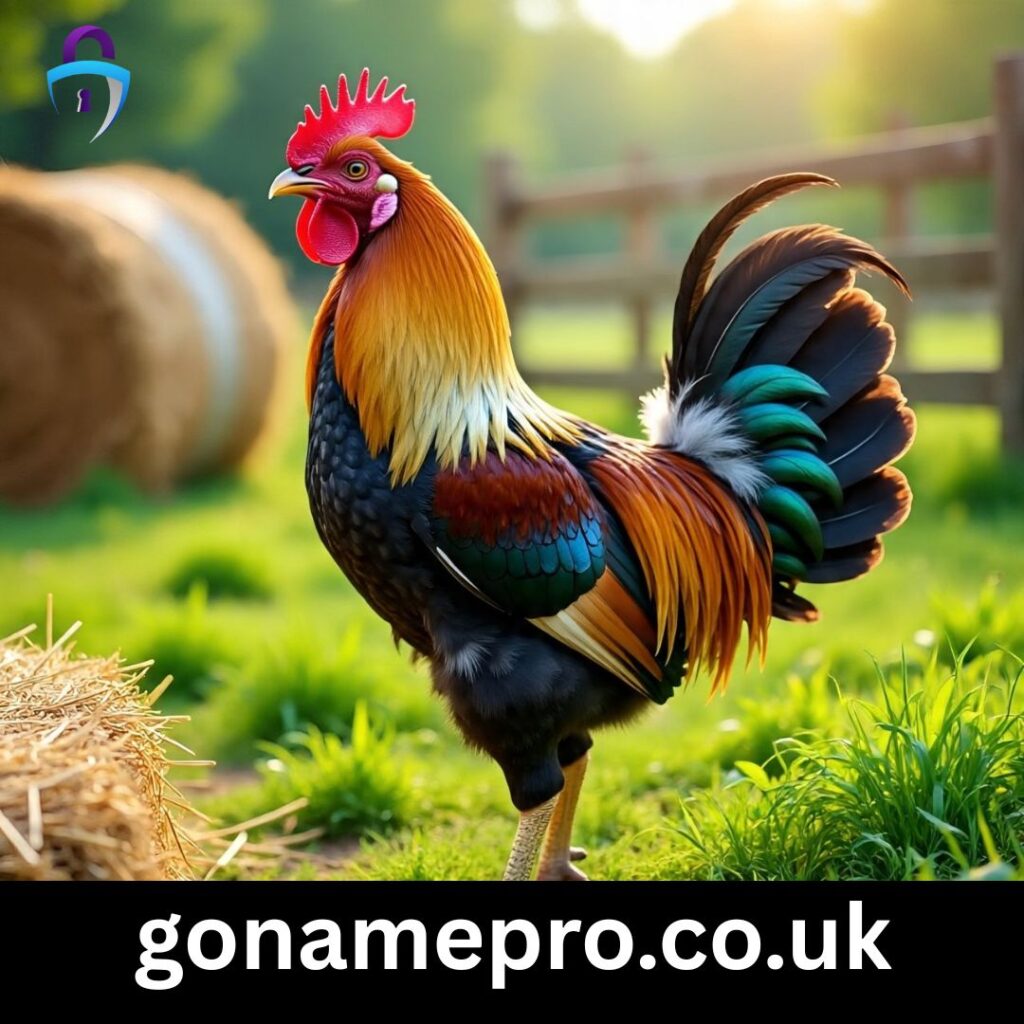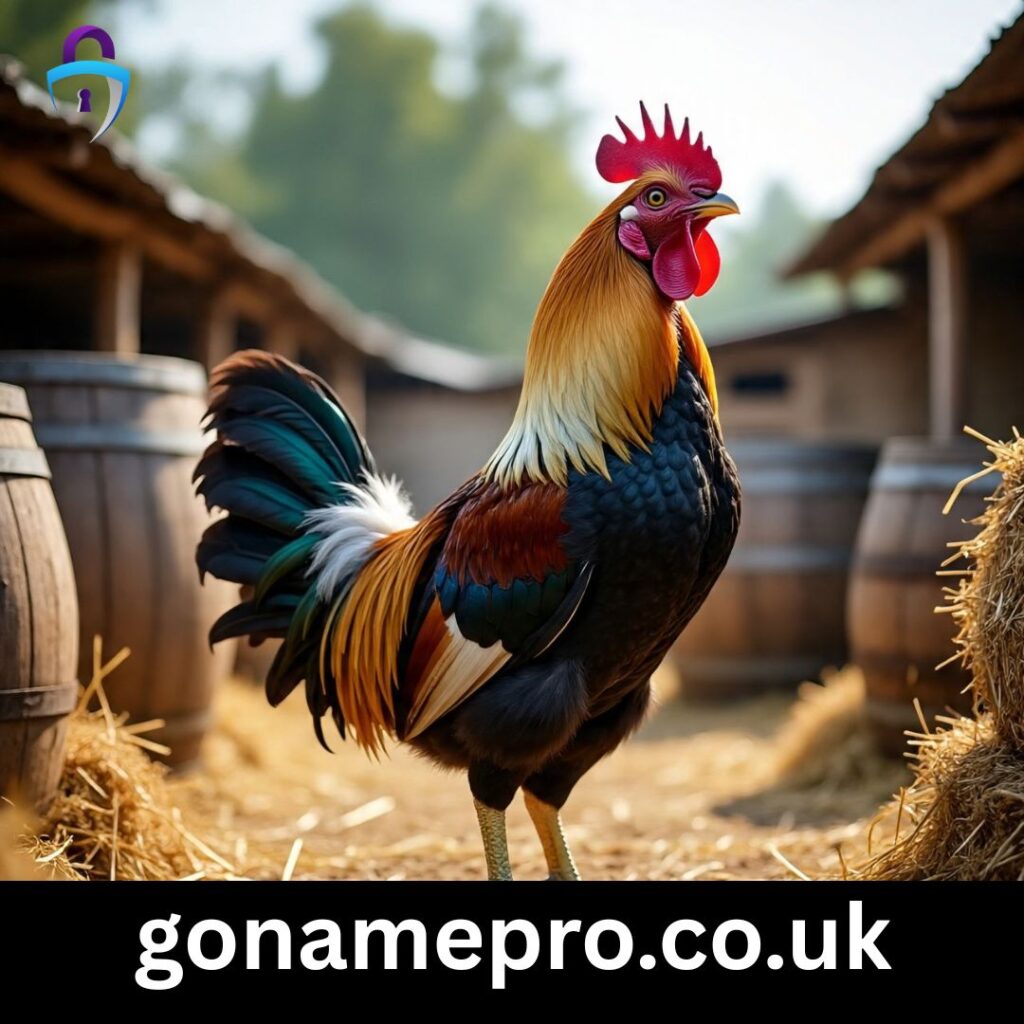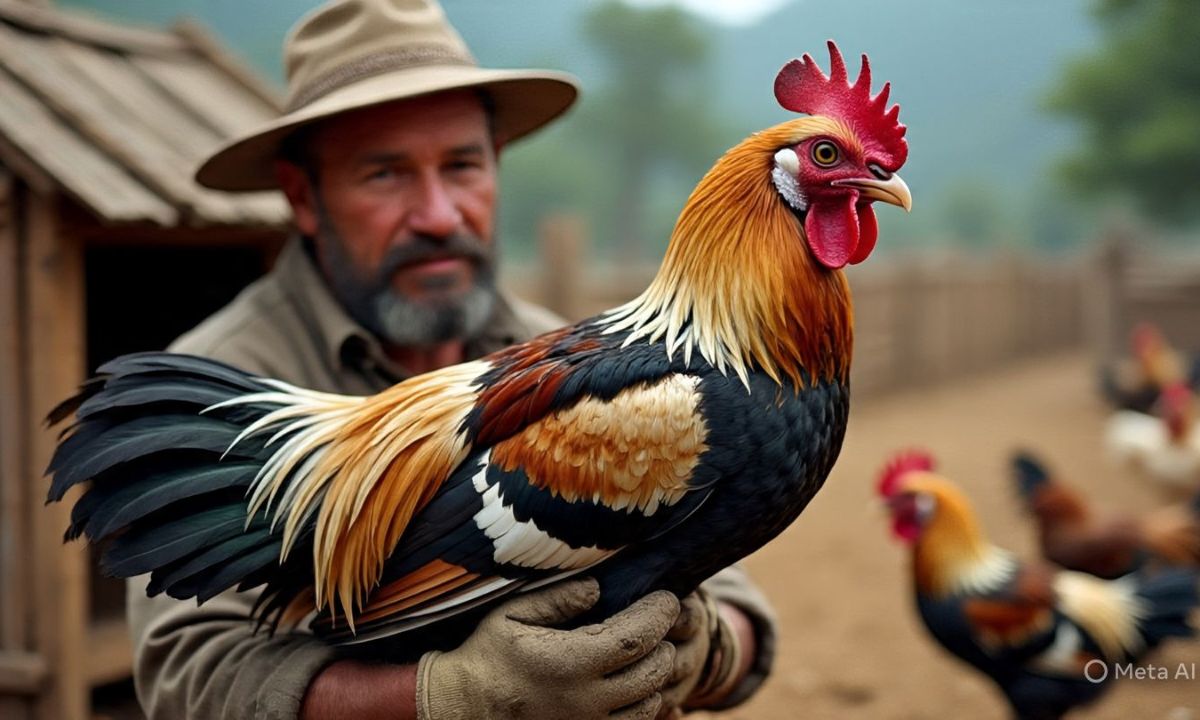Choosing a good fighting cock takes careful observation and knowledge. It’s not just about looks—it’s about strength, speed, and fighting spirit. The bloodline and breed play a big role in how the bird performs.
You also need to check the body structure, eyes, legs, and feathers. A good fighting cock must be alert, aggressive, and well-trained. Paying attention to these traits can help you pick a champion in the ring.
How to Choose a Good Fighting Cock Based on Head Shape 🧠🐓
- Broad head shows strong brain power 🧠
- Flat skull means good balance 🪵
- A square-shaped head is ideal 📦
- Head size should match the body 📏
- Firm skull means better impact 🥊
- Sloped head gives better pecking angle 🔺
- Wide forehead signals confidence 💪
- Smooth head skin shows health 💆♂️
- Bulky head means stronger bite 💥
- Small eyes on big head = focused 👀
- Rounded back head is preferred ⚪
- Avoid narrow, sharp head shapes ❌
- Balanced symmetry = better reflexes ⚖️
- Short beak, wide head = killer combo 🔫
- High dome shape gives vision boost 👁️
- Check if it’s firm when touched ✋
- A wide head shows good bloodline 🧬
- Strong jawline helps in clinch holds 🦷
- Skull thickness helps in hard hits 💢
- Flat top head fights smart 🧩
- Smooth curve between beak and skull 🌙
- Head tilt angle shows confidence 🎯
- Wide skull = better fight instincts ⚔️
- No dents or soft spots allowed 🚫
- Muscular neck and solid head = 💣
- Steady head = steady aim 🎯
- Avoid chickens with lopsided heads 🙅♂️
- A proud head stance shows dominance 👑
- Match head type to fighting style 🥋
- Big round head = power striker 🔨
- Alert head turns fast like radar 🛰️
- See how it holds head when angry 😤
- A clean head shows good health 💧
- Hard head helps in impact survival 🛡️
- Sharp eyes on solid head = deadly 🐍
How to Choose a Good Fighting Cock Based on the Tail 🪶🐓
- Tail should be wide and firm 🪭
- Slanting tail shows speed 🏃♂️
- Long tail = good balance ⚖️
- Curved tail points to strong roots 🌪️
- Dry, stiff tail feathers are ideal 🔥
- No wet or soft tails allowed 🚫
- Upright tail = confident posture 📏
- Straight tail = less drag in air 💨
- Tail must fan out wide 🪶
- Black glossy tail = healthy feathers 🖤
- Avoid crooked or short tails ❌
- Tail should move with body rhythm 🕺
- Lifted tail shows energy ⚡
- Tailbones must feel solid 🔩
- Strong tail = better jump control 🦘
- Tail tells the balance of the bird 🧘
- Feathers should look sharp ✂️
- Spread tail means high alertness 🚨
- Watch tail during sparring 🎥
- Weak tail = weak back support ⚠️
- Comb-like tail means heritage ✔️
- Tail mustn’t droop down 💧
- When angry, tail lifts—good sign 😡
- Clean tail area = healthy rooster 🧼
- Hard tail bones help in quick turns 🔄
- Black and red tail combo is lucky 🍀
- Tail should swing—not drag 🏋️♂️
- Balance tail with body size ⚖️
- Match tail shape with game style 🧠
- If tail sways fast, reflex is great ⚡
- A broad V-shaped tail is excellent ✅
- Avoid split or uneven tails 🚫
- Tail feathers should be tight 🌬️
- Pointed tail tips = smart moves 🧠
- Final test: tap it—see tail response 👋
Learn Why the Origin and Lineage of a Rooster Matter in Its Performance and Stamina 🧬🔥

- Bloodline decides strength 🧬
- Pure breeds perform better 💪
- Ancestry tells fighting history 📜
- Know the breeder’s reputation 👨🌾
- Strong lineage = high stamina ⚡
- Good parents = great fighters 🐔
- Choose well-known game breeds 🏆
- Crossbreed carefully for traits ⚖️
- Ask for lineage papers 📄
- Famous sires pass power 🧠
- See if past generation won fights 🥇
- Lineage decides style (cut, hold, fly) 🥋
- Old bloodlines = proven success 📊
- Avoid unknown or mixed blood 🚫
- Bloodline affects muscle density 💥
- Choose birds from active fighters 🐓
- Roosters carry fighting instincts 🧠
- A strong dam (mother) matters too 🐔
- Traits pass genetically 🧬
- Know region where it was raised 🗺️
- Some breeds have better air game 🛫
- Lineage gives health advantage ❤️
- Breeds from cool zones = tough skin ❄️
- Tropical birds have better endurance 🌞
- Ask for photos of parents 📸
- Meet the breeder for proof 👤
- Don’t gamble on unknown blood 🧪
- Track family wins like a pedigree 🏇
- Rooster’s blood defines strategy 🧠
- Look for heritage roosters 👑
- Avoid inbred lines 🚫
- Lineage affects mental toughness 💢
- Old warrior blood brings fire 🔥
- Choose bloodlines with titles 🥇
- Trust breeders who fight themselves 👊
Key Body Features Like Muscular Legs, Broad Chest, and Balance That Signal Fighting Potential 💪🐓
- Thick legs = power kicks 🦵
- Broad chest = better impact 💣
- Long thighs = faster moves 🏃♂️
- Straight stance = strong posture 🧍
- Deep chest = more stamina 💨
- Good muscle tone = strong hits 💪
- Check chest width with hand 📏
- Leg spacing shows coordination ⚖️
- Big shanks = strong grip 🦶
- Legs must feel solid to touch 🤲
- Flat back = balance booster ⚖️
- Firm body = higher resistance 🛡️
- Heavy bird but agile = perfect 🦅
- Check tail-chest-leg alignment 🔄
- Thick ankles = durable bird 💥
- Body must swing, not wobble 🌪️
- Compact yet flexible body 🧘
- Chest puffed naturally = confidence 🦚
- No fat—just pure muscle 🚫🍔
- Look at thigh rotation in jumps 🌀
- Short thick neck = control boost 🪢
- Center of gravity must be stable ⚖️
- Leg bones must be long and tough 🦴
- Flexibility with power is key 🔑
- Firm belly = strong core strength 🔩
- Bone density matters too 🧱
- Quick steps show coordination 👣
- Spreading wings shows full power 🪽
- Breastbone should be centered 🎯
- Watch it run—check stride 👟
- Feel the muscle with soft squeeze ✋
- Low body carriage = sturdy 🐢
- Balanced walk = great rhythm 🥁
- Don’t pick weak or light birds 🚫
- Well-shaped body = champion frame 🏆
These Facial Traits Often Reflect Health, Aggression, and Awareness in a Fighting Cock 👀🐓
- Sharp eyes = sharp brain 👁️
- Bright red comb = good health ❤️
- Strong beak = better strike 🐤
- No discharge from eyes/nose 🚫
- Long beak = good reach ✊
- Slightly curved beak = piercing 🦷
- Shiny eyes = high awareness ✨
- Comb must be upright & red 🔺
- Wattle should not droop ❌
- Beak must be hard when touched 🪨
- Look for symmetry in face ⚖️
- Facial skin should be tight 👌
- Clear vision helps attack first 🥇
- Observe eye movement—fast is good 👀
- Dull eyes = weak focus ⚠️
- Red or black eyes = fire inside 🔥
- Check nostrils—must be dry 🌬️
- Beak color should match breed 🎨
- No signs of injury or scars ❌
- Strong jaw muscles = better grip 🦷
- Aggressive stare is a green flag 🟩
- Pale face means illness ⚠️
- Natural fierceness in expression 😠
- Clean face = good hygiene 🧼
- Watch how it reacts to threat 👊
- Closed, tight beak when idle 🤐
- Heavy breathing = low stamina ❌
- Check skin around eye for damage 👁️
- Wrinkled face = older bird ⚠️
- Face must glow when excited ✨
- Facial feathers should be fine 🎯
- Open mouth during rest = avoid 🚫
- Watch for blinking rate 🕶️
- Strong look when flaring = great ⚡
- Nose & beak alignment should be perfect 📐
Assessing the Rooster’s Fierceness, Alertness, and Fighting Instinct is Crucial 🔥🐓

- Look for a rooster that paces constantly 🔄
- Watch how it reacts to noise 🎧
- Fierce eyes show true fighters 👁️🔥
- Pecks quickly when approached 🐤
- Aggressive toward other roosters ⚔️
- Puffed chest when challenged 💥
- Always alert—head turning fast 🧠
- Doesn’t shy away from touch ✋
- Charges at reflections or shadows 🪞
- Loud, confident crowing every morning 🗣️
- Stays upright and proud always 📏
- Moves with purpose, not laziness ⚡
- Eyes never lose focus 👀
- Responds fast to sudden movements 🚀
- Instinctively flares wings in fights 🪽
- Has a fiery look when annoyed 😠
- Reacts first during sparring 🥇
- Refuses to back down from a challenge 💪
- Fluffs feathers when angry 🪶🔥
- Watch how he reacts to strangers 👣
- Keeps distance but never afraid 👊
- Has a strong presence in the flock 👑
- Tests boundaries with other birds 📐
- Instinctively pecks and dodges 🥷
- Lunges forward when provoked ⚔️
- Doesn’t get scared by loud claps 👏
- Eyes locked on rival during faceoff 🎯
- Doesn’t tolerate weakness nearby 🧱
- Strong neck and head movements 🧠
- Expresses dominance with body language 🐓
- Doesn’t sleep in unusual postures 🚫
- Stands tall even when tired 🏋️♂️
- Tail and comb rise during tension 🔺
- Breathes steadily in tense moments 😤
- Has a natural warrior attitude 🛡️
Check for Strong, Well-Positioned Legs and Sharp Spurs that Give a Competitive Edge 🦵🔪
- Thick legs mean strong kicks 💥
- Spurs should point slightly upward 🔼
- Long legs help in dodging attacks 🦿
- Even leg length keeps balance ⚖️
- Hard bone texture when touched 🧱
- Legs must be well spaced apart ↔️
- No swelling or bumps on joints 🚫
- Spurs should be sharp and hard 💎
- Curved spurs have better grip 🌀
- Legs must not shake when standing 🧍♂️
- Yellow legs are a sign of energy 💛
- Straight stance with solid footing 🪵
- Toes must be straight and long 🦶
- Avoid bent or deformed claws ❌
- Clean between toes = good hygiene 🧼
- Strong ankles support fight movements 🔩
- Spurs should be well-placed, not too low 🎯
- Smooth skin on legs = healthy flow 🩸
- Kick reflex test: push lightly to check ⚔️
- Good grip on perch means strength 🪶
- Quick leg movements during spar = ✅
- See if bird lifts legs in defense 🛡️
- Test jump power from still position 🦘
- Spurs must grow sharp naturally 🔪
- Check for wounds—avoid damaged legs ❌
- Long back toe = better ground support 🧍♂️
- Watch how it lands after jumping 🚀
- Hard shin area = true fighter 🧱
- Quick sidestep ability = solid reflexes 💨
- No redness or flakiness on legs ❌
- Spurs match age and maturity 👴
- Footpad must be thick and round 🦶
- Natural scratching motion shows instincts 🐾
- Heel must absorb shock on jumps 🛑
- Clean, sharp spurs = game-ready 🧼🔪
Healthy, Tight Feathers and Smooth Molting Cycles Indicate Readiness and Vitality 🪶✨
- Feathers should shine under light 🌟
- Tight feathers = good health 💪
- No bald patches or loose tufts ❌
- Look for even feather layers 📏
- Molts once a year in regular rhythm 🔁
- Avoid birds molting too long ⏳
- Soft but dense body feathers 🧸
- Feathers must hug the body tight 🤗
- Dry feathers—never greasy or oily 🚫
- Shiny tail feathers = energy 🔋
- Wing feathers should be firm 🪽
- Feathers shouldn’t fall off when touched 🙅♂️
- Healthy feathers resist cold 🧊
- No feather mites or bugs 🐜
- Watch for clean feather shafts 👀
- Color should be even and vibrant 🎨
- Tail should fan evenly in motion 💃
- Avoid brittle or broken feathers 🚫
- Smooth neck feathers = confidence 😎
- Fast molting = faster recovery 🔄
- Smooth molt means low stress 🧘
- No blood spots on growing feathers ❌
- Good feather coverage on thighs 🦵
- Clean under-wing feathers 🧼
- Don’t choose patchy molters ⛔
- Neck-to-tail feather flow = fighter form 🐓
- Bright feather color = vitality 💥
- See how it shakes its feathers 🌀
- Preening often = self-care ✅
- Groomed wings show smart instinct 🧠
- Compact body feathering = strong defense 🛡️
- Feather sheen = healthy oils 💧
- Calm molting bird = stress-free 🧘♂️
- New feathers grow fast = strong genes 🧬
- Good feather health = ready to fight 💣
Frequently Asked Questions
How do I know if a fighting cock has good stamina?
Stamina is one of the most important traits for a fighting cock. A rooster that tires quickly will struggle to win in longer battles. Look for signs like steady breathing, consistent energy, and quick recovery after movement.
What is the ideal weight for a fighting cock?
Weight plays a big role in speed, balance, and impact. A rooster that’s too heavy may be powerful but slow, while one that’s too light might lack force. Balance is key—weight should match body build and style.
How often should a fighting cock be trained?
Daily short exercises and sparring every few days help build speed, coordination, and aggression. Overtraining, however, can cause injury or stress, especially during molting or after a fight.
Can the comb and wattle indicate health?
Pale, dry, or sagging combs may indicate sickness, dehydration, or fatigue. The comb is a visual health check—any major color or shape change should be noted immediately.
Should I consider the bird’s behavior outside the ring?
A fighting cock that is overly nervous or aggressive in normal conditions might lack control during fights. Look for birds that remain alert, but not fearful or overly reactive.
Conclusion
Choosing a good fighting cock requires more than just a quick glance. It’s a detailed process involving physical traits, fighting instincts, health signs, and behavioral patterns. From head shape to spur sharpness, every feature plays a role.
By understanding the signs of strength, stamina, and readiness, breeders and handlers can increase their chances of raising a true champion. Proper care, training, and selection lead to victory—both in the ring and in breeding legacy.

James Anderson expert at GoNamePro, crafting unique group, sports, game, and school names to inspire creativity and identity.





![A Field Guide to Biblically Accurate Demons (and Their Leader) [Bible Verses]](https://gonamepro.co.uk/wp-content/uploads/2025/09/A-Field-Guide-to-Biblically-Accurate-Demons-and-Their-Leader-Bible-Verses-1-150x150.jpg)
